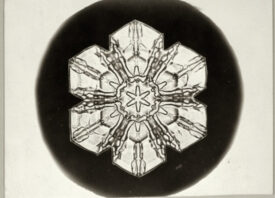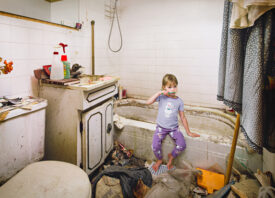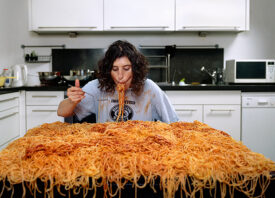Search this site
Uncanny Photos Explore the Meaning of Home



“I came across this abandoned house in the Central Valley of California,” the fine art photographer Lisa Levine tells me. “It’s a very small, humble, and unassuming house with peeling paint and boarded-up windows and door, with a banner on it that says ‘HOUSE’ draped across the front. A house that shows no signs of its inhabitants is simply a house, not a home, just as the banner reads.”
The abandoned house lingered in her memory and followed her home. She soon returned to the photos she’d taken there, removing that house from its real-life surroundings and placing it in a lush and verdant landscape. The landscape also exists in real life, though she’s changed its context. She’s since lifted many existing houses and relocated them someplace else, as part of her series Virtually No Place Like Home, an ongoing investigation into the meaning of home.
Levine grew up in New York City; though she lived in apartments during her early years, she often biked through neighborhoods with single-family houses. “These houses always fascinated me with their widely varying architectural styles, color, landscaping, and other forms of decoration,” she says now. “I was especially attracted to homes that displayed statues, particularly those relating to religion. The display of saints and icons seemed to me to be something very personal made public.”
After moving to California as an adult, she continued to photograph homes with statues, religious icons, and decorations that spoke to the inner worlds of the people who lived there. “There was one house that initially sparked my interest,” Levine remembers. “It’s a very small house with a high iron fence going all around it, located near my Oakland studio. It has only about four feet of distance between the house and the fence, and in this small area, there were numerous Christmas decorations packed closely together.”
In her imagination, and later in her studio, she picked up the house and moved it. “I thought that it would be interesting to see this house, with such limited space within the fenced-in area, in a wide-open landscape,” she says. “It seemed to make a certain amount of sense in a rough Oakland neighborhood, but how would it read in a desolate, open landscape? That question and that house are where I began this series.”
At the same time, Levine was orienting herself within that very landscape. “When I first moved to California from New York and traveled through the Central Valley I was, quite frankly, horrified by the landscape,” she admits. “This landscape was that of corporate farms stretching as far as you can see with no signs of human inhabitants anywhere. And where there was no farming, there was simply brownish-gray wasteland.
“I was used to the bucolic farmlands of upstate NY with small houses and barns dotting the green hillsides. Traveling through the Central Valley, I might as well have been on the moon. And the signs of the seasons were totally reversed; it was green in the winter and brown in the summer.
“I have since, however, come to love this ‘barren-scape’ and I’ve sought out these types of landscapes in other Western states as well. I’ve come to love the golden brown color of the dry land against the expansive blue of sky. I have returned to this type of landscape time and again because it is so foreign and fascinating to me, even after living in the West for several decades.”
Virtually No Place Like Home intentionally blurs the line between fact and fiction. At first glance, Levine wants us to believe, but she also wants us to take a second look and realize that something isn’t quite “right.” This idea of the uncanny is something she sees throughout photography today, beginning with the highly edited, endlessly perfected “selfies” we share online.
It feels appropriate that collectors can purchase the photographs as traditional physical prints–archival pigment prints on photo rag–and as NFTs, digital assets stored on the blockchain. As in the images themselves, the artist’s choice to release both further probes at the boundaries between the “real” world and the virtual one, questioning our ability to distinguish between the two as they evolve and overlap.
The process of creating a convincing illusion requires hours if not days. “My process begins with photographing houses and landscapes separately,” Levine says. “I have quite an archive of these images. I also photograph objects such as statuary, banners, signs, and discarded items that I see outside people’s homes. In post-processing, many of these objects, landscapes, and homes get recombined. I also often change or enhance the color of the houses I’ve photographed.”
During the pandemic, her understanding of the series shifted. As she sheltered in place, her mind turned back to the question at the heart of these images: What separates a house from a home? “The solitary houses and expansive landscapes began to speak of physical and social isolation; both the safety and comfort and the loneliness and exile of home,” she reflects. “I felt there was a new sense of urgency in using the home’s exterior to show who lived within and what was important to them.
“I saw many new manifestations of this need to share and express these concerns in the homes I encountered during this period. The 2020 ‘Shelter in Place’ holiday season was the impetus for a new series, Virtually No Place Like Home (for the Holidays). During that holiday season, the desire to bring light into the darkest of times was particularly evident. I noticed that many peoples’ holiday decorations were more elaborate than in years past, and many people left their decorations up well beyond the end of the holiday season.”
In some of her more recent images, Levine has started to construct entirely new, make-believe houses using elements pulled from various buildings. Here and there, she’s even incorporated bits and pieces of her own house, though it’s impossible to tell where any of the foundationa components originated. Truthfully, though, she’s always been more interested in strangers’ houses, with all their hidden implications. She tells me, “I aggregate other peoples’ stories and make them partially mine as well.”
Lisa Levine has an exhibition opening on October 20th at the Dortort Center for Creativity in the Arts at University of California Los Angeles Hillel.









All images © Lisa Levine



